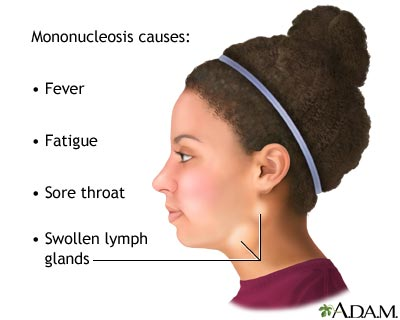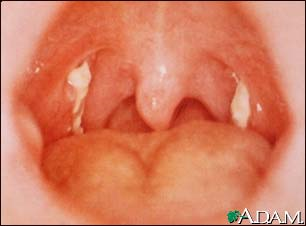Mononucleosis
The “Kissing Disease”
Mononucleosis is a viral infection most often caused by the Epstein-Barr virus (EBV), one of the most common viruses that infect humans. By the age of 40 years, almost all adults in the United States have been infected by EBV at some time during their lives. Most people are unaware of this because the virus either caused very mild symptoms or no symptoms at all during their early childhood years. However, if a person is first infected as a teen or young adult, EBV is more likely to cause the classic symptoms of infectious mononucleosis. It occurs more often in 15- to 25-year-olds, possibly because of more intimate contacts with others. Mononucleosis (sometimes called mono, the kissing disease, or glandular fever) is a viral infection transmitted through saliva. The common symptoms of mononucleosis include fever, sore throat, swollen lymph nodes, and fatigue. In some cases, an enlarged spleen may result. The diagnosis is made after a thorough history of symptoms along with a physical examination and laboratory testing. Contrary to popular belief, mono is not very contagious. Even people in the same household rarely come down with it. After the virus enters the body it can take 4 to 7 weeks before symptoms begin. There is no specific treatment for mononucleosis. Supportive measures such as bed rest, fluids, and pain relievers are all useful to relieve symptoms. Antiviral and antibacterial drugs are not effective in the treatment of mononucleosis. Activity is usually limited during the period of recovery, which may last for several weeks depending on the patient’s level of fatigue. Several months of extra rest may be required to completely recover from mononucleosis. Participation in vigorous sports or exercise is typically restricted for a month or more after symptoms subside to encourage quick recovery and avoid rupturing a potentially enlarged spleen.
The symptoms of mono may include:
- Severe sore throat
- Large red tonsils covered with pus
- Swollen lymph nodes in the neck, armpits, and groin
- Fever for 7 to 14 days
- Tiredness and increased sleeping
- Enlarged spleen (in 50% of children)
- Blood smear showing many atypical (unusual) lymphocytes
- Positive blood test for mononucleosis
- Hepatitis, with elevated liver function test, and occasional jaundice.
- Puffy eyes


How long does it last?
Some patients take a long time to recover, and some may develop serious complications including inflammation of the liver, heart, and nervous system. Complications may be related to “overdoing it” which may activate “Viremia” (The presence of viruses in the blood.) if mono is still present. It is important for patients to “listen to their body’s signals and rest when fatiguing easily. Patients should be out of school until fever, sore throat, fatigue and other symptoms have resolved. Other activities should not be added until patient is able to handle full days of school without fatigue.
